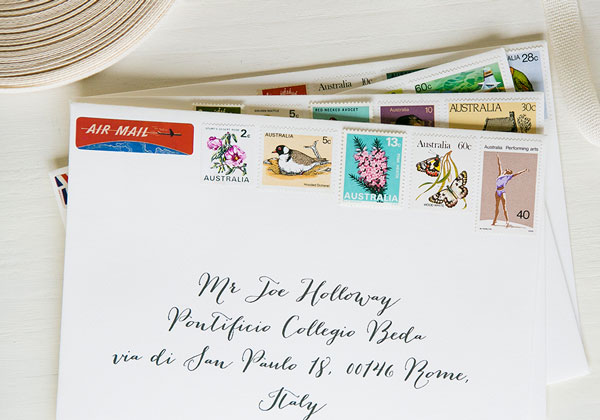
Saint Gertrude Vintage Stamps – Photo by Luke Lornie
Every day I meet engaged couples overwhelmed by the unknowns of the wedding invitation process. The best way I have found to demystify the experience is to liken wedding invitation design to wedding dress design. After all, we understand (sometimes a little too well) how fashion works. You can walk into a shop and buy a dress in your size or you can seek out a dressmaker to create a dress that is one-of-a-kind.
Makes sense, no? Well here’s the good news: designing wedding invitations is exactly the same.
COUTURE: one-of-a-kind wedding invitations
While the literal translation of ‘couture’ is ‘sewing’ (and in the case of haute couture, high sewing), it is a term now widely used to describe custom or catwalk garments. These designs are rarely available for people to buy in shops: they are custom-made for special occasions and shows. Almost every dress worn on the red carpet at the Oscars is a Couture design (I say almost because apparently Helen Hunt wore an $80 dress by H&M this year – who knew!?)
Similarly, wedding invitations can be Couture designed. This means that you don’t have to select an invitation that is ‘current’ or ‘trending’, you can work with your designer to make something as simple or as intricate as you like using various fonts, hand-lettering or custom illustration. The design is 100% YOU and, most of the time, the sky (and your budget) is the limit.
Timeframe: allow 8 weeks to 4 months design and production time
Cost: allow $10 to $40 per invitation
PRÊT-À-PORTER: wedding invitations off-the-shelf
The literal translation of Prêt-à-Porter is a little more fitting (no pun intended): Ready-to-Carry. Design houses release Prêt-à-Porter collections so that customers can select a pre-designed dress in their choice of size and fabric. Most wedding dresses are actually bought this way; brides select a dress off the rack and have it made to fit their body. They have limited control over the design elements and fabrics and accept the dress more or less ‘as is’.
Again, wedding invitations can be purchased just like this. Select an invitation from a designer’s portfolio, supply your own wording and customise it with your choice of colour. Much like a dress, you will have limited control over the design elements and may not be able to change things like fonts or images.
Timeframe: allow 3-6 weeks design and production time
Cost: allow $4 – $15 per invitation
PRINT: sewing your wedding invitations
Once an invitation has been designed, it goes off to be printed and assembled. This is like the ‘sewing’ of the dress and the paper is the fabric. There are many different specialty print methods available, but the following three are the most popular right now.
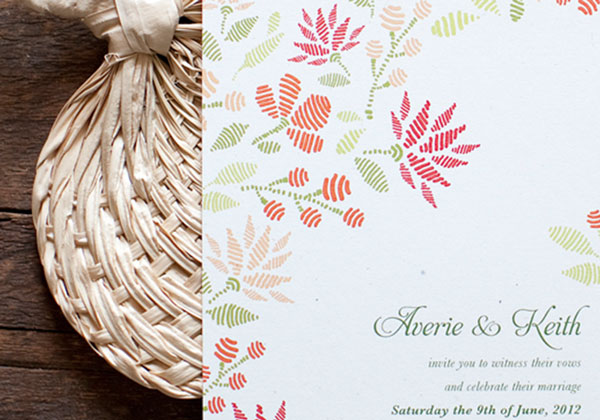
Digital Printing: the cheapest and most widely used printing process. Invitations are printed on a Xerox laser printer or similar.
Pros: it’s cheap and quick and can even be done at home.
Cons: it can look a little basic, and the printers can’t usually handle textured or thick paper. Simple designs can look a bit underwhelming and small details can be lost.
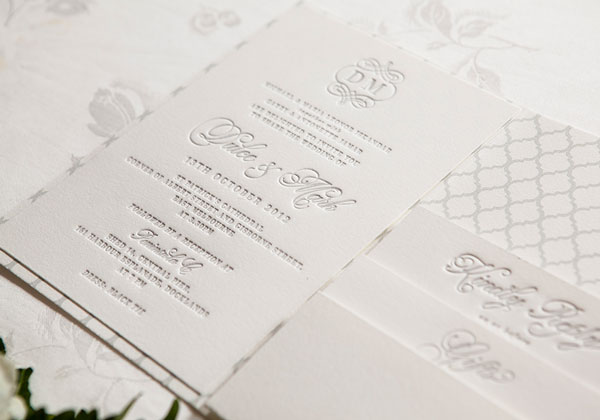
Saint Gertrude Letterpress ‘Dulce & Mark Suite’ Photo by Luke Lornie
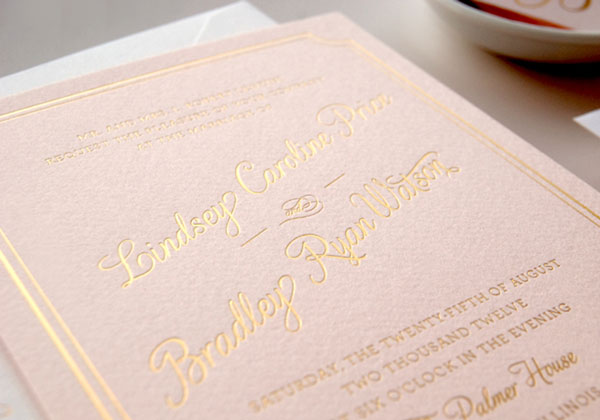
Letterpress: this old print method is gathering popularity for its tactile beauty. Invitations are printed on an antique printing press and the design is literally etched into thick cotton paper. Using the same machines, foil stamping is also available which offers a similar look but with shiny metallic foil instead of ink.
Pros: it looks beautiful and the papers are soft and luxurious. Even a very simple design will pop in letterpress.
Cons: it’s more expensive and it takes more time than digital printing. Letterpress is not for people on a tight budget or in a hurry – it will add at least 2 weeks to the production process. There are some quirky design limitations so it’s best to work with a designer who is experienced with letterpress.
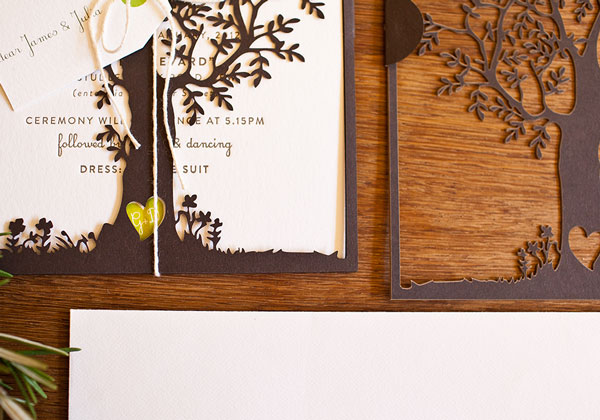
Saint Gertrude Letterpress “Georgie & Dave Suite” Photo by Luke Lornie
Laser-cutting: this modern approach to invitations is experiencing a huge resurgence in popularity. A machine cuts a silhouette out of paper to create a little piece of paper cut art.
Pros: again, insanely beautiful and eye-catching.
Cons: it can be expensive and time-consuming and should only be attempted by a designer with laser-cutting experience.
ETIQUETTE: the when and how of sending wedding invitations
Fear not, brides and grooms… this bit isn’t as hard as you may think. Here are the most commonly asked questions about the practical side of wedding invitations.
1. Timing
When should I send wedding invitations? The best window of time to send wedding invitations is 8-12 weeks prior to your wedding. 6 weeks is acceptable for a small or local wedding. Don’t be bullied by people who try to pressure you to get your invitations out 6 months in advance – it’s actually not advisable to do so. Things beyond your control can change in the months leading up to your wedding and reprinting wedding invitations is an unnecessary expense.
2. Wording
The honour of my pleasure is cordially…. huh? I won’t lie, the wording of wedding invitations can be a minefield. There are many rules and almost as many exceptions but guess what? You’re only having one wedding. You need only know the ins and outs of that one type of wedding so don’t stuff your brain with etiquette information that is completely irrelevant to you. Rather than wasting your time and energy googling wording etiquette tips (which will be America-centric and contradictory) leave it to the professionals and ask for help. A good stationer knows their etiquette and will ask the right questions to ensure your invitations are worded correctly.
3. Guest List
The great guest list dilemma. Again, there are a lot of etiquette rules regarding how to address invitations and envelopes. But here’s the good news: Australia has a gracious and down-to-earth attitude to social graces. As a very rough guide to addressing your guests, the husband is listed before the wife and, in non-married couples, the names are listed in alphabetical order. For any curly ones like doctors or honourable persons, talk to your stationer about the individual dilemma. A good stationer knows etiquette, but they also know their Ms from their Miss.
FOCUS: keep calm and carry a mood board
Mood boards help you to keep a record of the things you love and websites like Pinterest and Lover.ly are a great online resource for ensuring you stay focused on your wedding style. Use your mood board to describe your needs to your stationer and when selecting or finalising wedding details. Does it match my mood board? Yes? Go for it!
![]()
Ms Gingham says: So much practical advice! I love the explanation of all the different print types and design costs!
About Saint Gertrude: Saint Gertrude is a small design studio and letterpress workshop in Melbourne, Australia. Named after Gertrude Street Fitzroy, the traditional printers district of Melbourne, we are a dedicated letterpress studio, printing all of our creations in-house on a hand-fed, 100-year-old platen press. Our aim is to create exquisitely unique letterpress work that pushes the proverbial envelope. Weddings are our signature dish but we also love creating tactile letterpress stationery and prints.





This is a wonderful post ‘demystifying’ the whole wedding invitation issue. Must read for couples-in-planning!
Very nice article, if i consider this years orders than i would say letterpress is more popular than digital printing, at least this is my experience.
Thanks for comprehensively covering all things related to wedding invitations. I’m totally recommending this page to my clients who are still needing some help and tips for their invites.